Unstoppable innovations of additive manufacturing
18.06.2019
EXTREME WEIGHT REDUCTION TO INCREASE PERFORMANCE AND PROVIDE ENVIRONMENTAL BENEFITS
The new frontier of additive manufacturing
In the latest years, 3D printing has been revolutionizing the design of components in several sectors, including transportation. This new technology consists of the creation of a product starting from a virtual 3D model that is printed layer by layer by adding material to make the finished piece.
For this reason, “3D printing” is often called “additive manufacturing”, in contrast to traditional “subtractive manufacturing” processes consisting of the typical removal of material by machining.
After the additive manufacturing process, some finishing activities are necessary, such as the removal of the piece from the substrate on which it was printed and some machining operations to obtain adequate levels of surface finish and appropriate heat treatments. In any case, these finishing operations are minimized compared to traditional technology thanks to the possibility of obtaining very complex geometries. One of the greatest advantages of this technology is, in fact, the absence of formability constraints typical of traditional technologies and therefore the possibility of creating shapes not even imaginable with traditional techniques. The possibility of creating such complex geometries guarantees a strong weight reduction of the component, as it is possible to put material only where the piece is really stressed in working conditions.
A strongly accelerated process
Production cycle times are now high, which is why the technology is mainly used for prototyping or special applications (e.g. in aerospace).
A significant trend in this sector is leading to a considerable speeding up of the process, so, in the future, the additive manufacturing could become efficient even for small series.
One solution is to maximize productivity by optimizing the positioning of parts on the machine, exploiting the available space as much as possible. The productivity of these machines also passes through the increase in the number of laser heads working simultaneously and the increase in the power of the laser sources, so as to increase the widths of the laser beams and the speed: according to the people interviewed, the targets for the next 10 years are to increase productivity by 8 times.
Additive Manufacturing for the design of a new connecting rod
Streparava has applied this technology as part of an innovation project, in which a connecting rod has been completely redesigned to reduce its weight and maximize engine performance. During the project the geometry was modified so that the component weighed as less as possible, while maintaining its operating performances.
The component obtained weighs 15% less than the corresponding forged titanium connecting rod and 45% less than forged steel. The resulting shape is achievable only with this innovative technology. These results required the use of topological optimization software and structural analysis.
The project was carried out in collaboration with EOS, one of the most important manufacturers of machines for additive manufacturing. In addition to the components, a series of ad hoc designed specimens were printed to evaluate the real mechanical and metallurgical performance of this new material. The specimens are now being analyzed in collaboration with the Department of Mechanical and Industrial Engineering of the University of Brescia in order to define the most suitable post-process parameters.

Weight reduction is the basis
A patent application has recently been filed for this component, which could potentially be applied to sectors where high performance is required (superbike, sports car, etc.). The weight reduction is in fact a very sensible parameter for these vehicles and the limited production volumes are aligned with the current limits of this new technology. With this project we are continuing our roadmap by proposing more and more extreme weight reduction solutions thanks to the application of the most advanced technologies and materials.
NEWS
Plant
Presence in the world
With 9 facilities in the world, Streparava produces chassis and powertrain components with an high degree of precision, supplied to the major OEMs for motorcycles, automobiles, buses, industrial and commercial vehicles.
